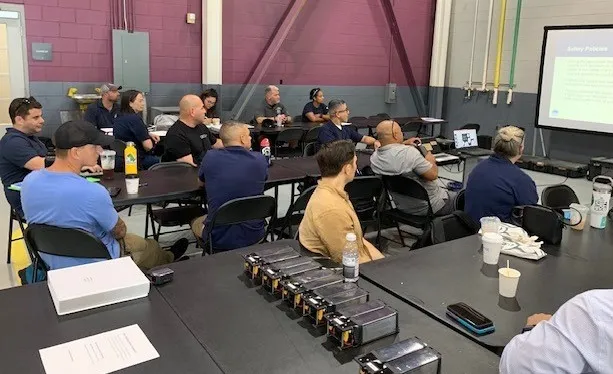S&T brought law enforcement personnel from all over the country to the fields of Mississippi to test and evaluate a new way to communicate with crowds.
On a hot and humid July day in a field of corn and soy plants, a large unmanned aircraft system (UAS), or drone, was buzzing a hundred feet above a small group of people. With their eyes on the sky, these first responders and evaluators with clipboards from the Science and Technology Directorate’s National Urban Security Technology Laboratory (NUSTL) stood 15 feet away from a speaker on the ground blaring the sounds of a huge and raucous crowd at them.

Through all of the noise came a loud, and surprisingly clear, voice from the drone hovering far above, “Please exit to the north side of the plaza.”
This was just one of the tests performed at the recent OFA for the Bellbird Aerial Communications Platform, held at Mississippi State University in Starkville, Mississippi.

Designed and prototyped for S&T’s First Responder Capability program by Cornerstone Research Group (CRG), the Bellbird was conceived as a safer, more efficient way for law enforcement and first responders to share critical emergency information with large crowds.

Many agencies currently rely on bullhorns or Long Range Acoustic Devices mounted on vehicles to communicate with crowds, but those methods may only reach a limited section of the crowd, leaving large numbers of people potentially unaware of what first responders are trying to tell them. For the Bellbird, S&T and CRG equipped existing UAS technology with a large speaker and a boom microphone to facilitate two-way communication with large crowds while maintaining a safe distance. The speakers will amplify critical emergency instruction throughout the crowd, while the microphone will enable individuals to relay on-the-ground information back to responders for enhanced situational awareness.

Brenda Long is a Program Manager in the First Responder Capability program and oversees the Bellbird effort for S&T. “The OFA is testing the maneuverability of the drone and trying to make sure that it works the way that the first responders will need it to. Is it loud enough? Is it clear enough for people to hear? The idea is to have very clear messages to the crowd, to help keep them safe, and to keep the first responders safe.”

The test was designed and conducted by a team from NUSTL, one of five S&T national labs. “Our lab serves as a technical advisor to first responders, primarily at the state and local level, but we support the Department of Homeland Security components as well,” said Patel. “A big part of that is conducting tests and evaluations on emerging technologies, and on commercially available technologies, trying to get to the ground truth of how these technologies work and whether or not they are going to be effective for first responders to use out in the field.”
The first responders that gathered for the OFA all took turns assembling, flying, and programming the announcements on the Bellbird.
Matt Didier, a Lieutenant with the Seattle Police Department, thought the bellbird had a lot of potential. “I was actually surprised at how clearly I could hear it when it was a hundred feet off the ground and a hundred feet away from us, while 80 plus decibels of background noise was going on around me. That would be an ideal location when working with crowds, because it's keeping us away from the crowd for safety of the crowd, but still able to deliver a clear message.”

NUSTL will issue a report later this year outlining findings from the OFA and then Long and her team will move forward with any modifications and fine-tuning the participants recommended. The goal, as always, is to equip first responders with the tools they need to keep all of us safe.
For additional information about the Bellbird and S&T’s ongoing first responder research and development efforts, contact STMedia@hq.dhs.gov.
